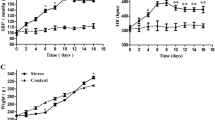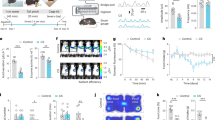Abstract
We previously reported behavioral and electrophysiological evidence indicating that superior cervical ganglia (SCG) from rats that developed hypertension as a result of chronic psychosocial stress expressed ganglionic long-term potentiation (gLTP) in vivo. In the present study, we present additional supportive evidence by measuring changes in protein levels of essential signaling molecules in ganglia from chronically stressed rats. We compared protein levels of essential, LTP-related signaling molecules in ganglia isolated from chronic stress-hypertensive rats, known to have expressed gLTP, with those of the same molecules in normal ganglia 1h after eliciting gLTP by high frequency stimulation (HFS) in vitro. Immunoblot analysis showed a significant increase in the levels of phosphorylated CaMKII, total CaMKII, nitric oxide synthase (NOS-1), and calmodulin in SCG from both chronically stressed rats and from normal rat ganglia in which gLTP was expressed by HFS in vitro. Additionally, there was a parallel reduction in calcineurin protein levels in ganglia from both groups. The present results confirm that ganglia from stressed rats have expressed gLTP in vivo and that synaptic plasticity in sympathetic ganglia may involve a molecular cascade largely similar to that of LTP in the hippocampal CA1 region.






Similar content being viewed by others
References
Alkadhi, K. A., & Altememi, G. F. (1997). Nitric oxide mediates long-term potentiation in rat superior cervical ganglion. Brain Research, 753, 315–317.
Alkadhi, K. A., Salgado-Commissariat, D., Hogan, Y. H., & Akpaudo, S. B. (1996). Induction and maintenance of ganglionic long-term potentiation require activation of 5-hydroxytryptamine (5-HT3) receptors. Journal of Physiology, 496(Pt 2), 479–489.
Alkadhi, K. A., Al-Hijailan, R. S., Malik, K., & Hogan, Y. H. (2001a). Retrograde carbon monoxide is required for induction of long-term potentiation in rat superior cervical ganglion. Journal of Neuroscience, 21, 3515–3520.
Alkadhi, K. A., Otoom, S. A., Tanner, F. L., Sockwell, D., & Hogan, Y. H. (2001b). Inhibition of ganglionic long-term potentiation decreases blood pressure in spontaneously hypertensive rats. Experimental Biology and Medicine (Maywood), 226, 1024–1030.
Alkadhi, K. A., Alzoubi, K. H., & Aleisa, A. M. (2005a). Plasticity of sympathetic transmission in autonomic ganglia. Progress in Neurobiology, 75, 83–108.
Alkadhi, K. A., Alzoubi, K. H., Abdulaziz, A. M., Tanner, F. L., & Nimer, A. S. (2005b). Psychosocial stress-induced hypertension results from in vivo expression of long-term potentiation in sympathetic ganglia. Neurobiology of Disease, 20, 849–857.
Alkadhi, K. A., & Alzoubi, K. H. (2007). Role of long-term potentiation of sympathetic ganglia (gLTP) in hypertension. Clinical and Experimental Hypertension, 29, 267–286.
Alonso-deFlorida, F., Morales, M. A., & Minzoni, A. A. (1991). Modulated long-term potentiation in the cat superior cervical ganglion in vivo. Brain Research, 544, 203–210.
Altememi, G. F., & Alkadhi, K. A. (1999). Nitric oxide is required for the maintenance but not initiation of ganglionic long-term potentiation. Neuroscience, 94, 897–902.
Alzoubi, K. H., Aleisa, A. M., & Alkadhi, K. A. (2006). Molecular studies on the protective effect of nicotine in adult-onset hypothyroidism-induced impairment of long-term potentiation. Hippocampus, 16(10), 861–74.
Bachoo, M., & Polosa, C. (1991). Long-term potentiation of nicotinic transmission by a heterosynaptic mechanism in the stellate ganglion of the cat. Journal of Neurophysiology, 65, 639–647.
Bachoo, M., & Polosa, C. (1992). Preganglionic axons from the third thoracic spinal segment fail to induce long-term potentiation in the superior cervical ganglion of the cat. Canadian Journal of Physiology and Pharmacology, 70(Suppl), S27–31.
Bachoo, M., Heppner, T., Fiekers, J., & Polosa, C. (1992). A role for protein kinase C in long term potentiation of nicotinic transmission in the superior cervical ganglion of the rat. Brain Research, 585, 299–302.
Boone, J. L. (1991). Stress and hypertension. Primary Care, 18, 623–649.
Briggs, C. A., Brown, T. H., & McAfee, D. A. (1985). Neurophysiology and pharmacology of long-term potentiation in the rat sympathetic ganglion. Journal of Physiology, 359, 503–521.
Briggs, C. A., & McAfee, D. A. (1988). Long-term potentiation at nicotinic synapses in the rat superior cervical ganglion. Journal of Physiology, 404, 129–144.
Briggs, C. A., McAfee, D. A., & McCaman, R. E. (1988). Long-term regulation of synaptic acetylcholine release and nicotinic transmission: the role of cyclic AMP. British Journal of Pharmacology, 93, 399–411.
Brown, T. H., & McAfee, D. A. (1982). Long-term synaptic potentiation in the superior cervical ganglion. Science, 215, 1411–1413.
Cetiner, M., & Bennett, M. R. (1993). Nitric oxide modulation of calcium-activated potassium channels in postganglionic neurones of avian cultured ciliary ganglia. British Journal of Pharmacology, 110, 995–1002.
Dore, S., Takahashi, M., Ferris, C. D., Zakhary, R., Hester, L. D., Guastella, D., & Snyder, S. H. (1999). Bilirubin, formed by activation of heme oxygenase-2, protects neurons against oxidative stress injury. Proceedings of the National Academy of Sciences of the United States of America, 96, 2445–2450.
Esler, M., Julius, S., Zweifler, A., Randall, O., Harburg, E., Gardiner, H., et al. (1977). Mild high-renin essential hypertension. Neurogenic human hypertension? New England Journal of Medicine, 296, 405–411.
Gerges, N. Z., Stringer, J. L., & Alkadhi, K. A. (2001). Combination of hypothyroidism and stress abolishes early LTP in the CA1 but not dentate gyrus of hippocampus of adult rats. Brain Research, 922, 250–260.
Gerges, N. Z., Aleisa, A. M., Alhaider, A. A., & Alkadhi, K. A. (2002). Reduction of elevated arterial blood pressure in obese Zucker rats by inhibition of ganglionic long-term potentiation. Neuropharmacology, 43, 1070–1076.
Gerges, N. Z., Aleisa, A. M., Schwarz, L. A., & Alkadhi, K. A. (2003). Chronic psychosocial stress decreases calcineurin in the dentate gyrus: a possible mechanism for preservation of early ltp. Neuroscience, 117, 869–874.
Gerges, N. Z., Aleisa, A. M., Schwarz, L. A., & Alkadhi, K. A. (2004). Reduced basal CaMKII levels in hippocampal CA1 region: possible cause of stress-induced impairment of LTP in chronically stressed rats. Hippocampus, 14, 402–410.
Hadjiconstantinou, M., Potter, P. E., & Neff, N. H. (1982). Trans-synaptic modulation via muscarinic receptors of serotonin-containing small intensely fluorescent cells of superior cervical ganglion. Journal of Neuroscience, 2, 1836–1839.
Hanson, P. I., Kapiloff, M. S., Lou, L. L., Rosenfeld, M. G., & Schulman, H. (1989). Expression of a multifunctional Ca2+/calmodulin-dependent protein kinase and mutational analysis of its autoregulation. Neuron, 3, 59–70.
Hogan, Y. H., Hawkins, R., & Alkadhi, K. A. (1998). Adenosine A1 receptor activation inhibits LTP in sympathetic ganglia. Brain Research, 807, 19–28.
Johnston, D., & Wu, S. (1995). Foundations of cellular neurophysiology. Cambridge, MA: MIT Press.
Kandel, E. R., & Hawkins, R. D. (1992). The biological basis of learning and individuality. Scientific American, 267, 78–86.
Hoyer, D., Waeber, C., Karpf, A., Neijt, H., Palacios, J. M. (1989). [3H]ICS 205-930 labels 5-HT3 recognition sites in membranes of cat and rabbit vagus nerve and superior cervical ganglion. Naunyn Schmiedebergs Archives of Pharmacology, 340(4), 78–86.
Lin, Y. Q., & Bennett, M. R. (1994). Nitric oxide modulation of quantal secretion in chick ciliary ganglia. Journal of Physiology, 481(Pt 2), 385–394.
Magee, J. C., & Schofield, G. G. (1992). Neurotransmission through sympathetic ganglia of spontaneously hypertensive rats. Hypertension, 20, 367–373.
Maurice, D. H., & Haslam, R. J. (1990). Molecular basis of the synergistic inhibition of platelet function by nitrovasodilators and activators of adenylate cyclase: Inhibition of cyclic AMP breakdown by cyclic GMP. Molecular Pharmacology, 37, 671–681.
McEwen, B. S. (1998). Protective and damaging effects of stress mediators. New England Journal of Medicine, 338, 171–179.
Minota, S., Kumamoto, E., Kitakoga, O., & Kuba, K. (1991). Long-term potentiation induced by a sustained rise in the intraterminal Ca2+ in bull-frog sympathetic ganglia. Journal of Physiology, 435, 421–438.
Morales, M. A., Bachoo, M., Collier, B., & Polosa, C. (1994). Pre- and postsynaptic components of nicotinic long-term potentiation in the superior cervical ganglion of the cat. Journal of Neurophysiology, 72, 819–824.
Morales, M., Wang, S. D. (2002). Differential composition of 5-hydroxytryptamine3 receptors synthesized in the rat CNS and peripheral nervous system. Journal of Neuroscience, 22, 6732–6741.
Nichols, R. A., & Mollard, P. (1996). Direct observation of serotonin 5-HT3 receptor-induced increases in calcium levels in individual brain nerve terminals. Journal of Neurochemistry, 67, 581–592.
Pettit, D. L., Perlman, S., & Malinow, R. (1994). Potentiated transmission and prevention of further LTP by increased CaMKII activity in postsynaptic hippocampal slice neurons. Science, 266, 1881–1885.
Scott, T. R., & Bennett, M. R. (1993a). The effect of nitric oxide on the efficacy of synaptic transmission through the chick ciliary ganglion. British Journal of Pharmacology, 110, 627–632.
Scott, T. R., & Bennett, M. R. (1993b). The effect of ions and second messengers on long-term potentiation of chemical transmission in avian ciliary ganglia. British Journal of Pharmacology, 110, 461–469.
Sheng, H., Gagne, G. D., Matsumoto, T., Miller, M. F., Forstermann, U., & Murad, F. (1993). Nitric oxide synthase in bovine superior cervical ganglion. Journal of Neurochemistry, 61, 1120–1126.
Siegrist, J. (2001). [Psychosocial factors influencing development and course of coronary heart disease]. Herz, 26, 316–325.
Szilagyi, J. E. (1991). Psychosocial stress elevates blood pressure via an opioid dependent mechanism in normotensive rats. Clinical and Experimental Hypertension Part A, 13, 1383–1394.
Wang, J. H., & Kelly, P. T. (1995). Postsynaptic injection of CA2+/CaM induces synaptic potentiation requiring CaMKII and PKC activity. Neuron, 15, 443–452.
Acknowledgment
Support is contributed by a grant (0255402Y) from AHA-Texas Affiliate.
Author information
Authors and Affiliations
Corresponding author
Rights and permissions
About this article
Cite this article
Alzoubi, K.H., Aleisa, A.M. & Alkadhi, K.A. Expression of gLTP in Sympathetic Ganglia from Stress-hypertensive Rats: Molecular Evidence. J Mol Neurosci 35, 201–209 (2008). https://doi.org/10.1007/s12031-008-9054-x
Received:
Accepted:
Published:
Issue Date:
DOI: https://doi.org/10.1007/s12031-008-9054-x




